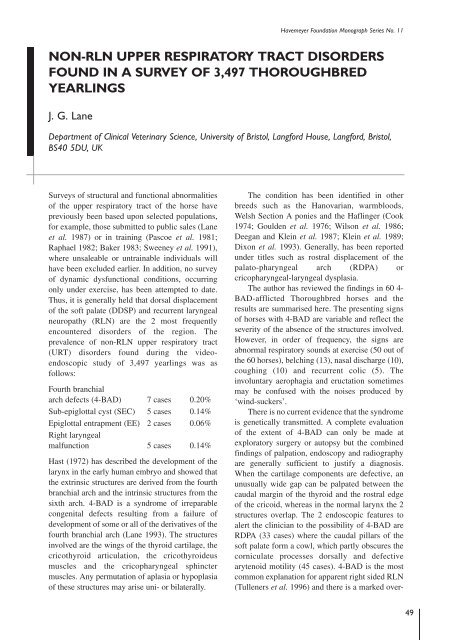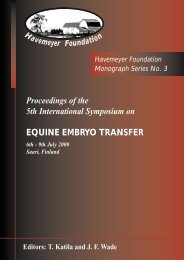Proceedings of a Workshop on - The Havemeyer Foundation
Proceedings of a Workshop on - The Havemeyer Foundation
Proceedings of a Workshop on - The Havemeyer Foundation
You also want an ePaper? Increase the reach of your titles
YUMPU automatically turns print PDFs into web optimized ePapers that Google loves.
<strong>Havemeyer</strong> Foundati<strong>on</strong> M<strong>on</strong>ograph Series No. 11<br />
NON-RLN UPPER RESPIRATORY TRACT DISORDERS<br />
FOUND IN A SURVEY OF 3,497 THOROUGHBRED<br />
YEARLINGS<br />
J. G. Lane<br />
Department <str<strong>on</strong>g>of</str<strong>on</strong>g> Clinical Veterinary Science, University <str<strong>on</strong>g>of</str<strong>on</strong>g> Bristol, Langford House, Langford, Bristol,<br />
BS40 5DU, UK<br />
Surveys <str<strong>on</strong>g>of</str<strong>on</strong>g> structural and functi<strong>on</strong>al abnormalities<br />
<str<strong>on</strong>g>of</str<strong>on</strong>g> the upper respiratory tract <str<strong>on</strong>g>of</str<strong>on</strong>g> the horse have<br />
previously been based up<strong>on</strong> selected populati<strong>on</strong>s,<br />
for example, those submitted to public sales (Lane<br />
et al. 1987) or in training (Pascoe et al. 1981;<br />
Raphael 1982; Baker 1983; Sweeney et al. 1991),<br />
where unsaleable or untrainable individuals will<br />
have been excluded earlier. In additi<strong>on</strong>, no survey<br />
<str<strong>on</strong>g>of</str<strong>on</strong>g> dynamic dysfuncti<strong>on</strong>al c<strong>on</strong>diti<strong>on</strong>s, occurring<br />
<strong>on</strong>ly under exercise, has been attempted to date.<br />
Thus, it is generally held that dorsal displacement<br />
<str<strong>on</strong>g>of</str<strong>on</strong>g> the s<str<strong>on</strong>g>of</str<strong>on</strong>g>t palate (DDSP) and recurrent laryngeal<br />
neuropathy (RLN) are the 2 most frequently<br />
encountered disorders <str<strong>on</strong>g>of</str<strong>on</strong>g> the regi<strong>on</strong>. <strong>The</strong><br />
prevalence <str<strong>on</strong>g>of</str<strong>on</strong>g> n<strong>on</strong>-RLN upper respiratory tract<br />
(URT) disorders found during the videoendoscopic<br />
study <str<strong>on</strong>g>of</str<strong>on</strong>g> 3,497 yearlings was as<br />
follows:<br />
Fourth branchial<br />
arch defects (4-BAD) 7 cases 0.20%<br />
Sub-epiglottal cyst (SEC) 5 cases 0.14%<br />
Epiglottal entrapment (EE) 2 cases 0.06%<br />
Right laryngeal<br />
malfuncti<strong>on</strong> 5 cases 0.14%<br />
Hast (1972) has described the development <str<strong>on</strong>g>of</str<strong>on</strong>g> the<br />
larynx in the early human embryo and showed that<br />
the extrinsic structures are derived from the fourth<br />
branchial arch and the intrinsic structures from the<br />
sixth arch. 4-BAD is a syndrome <str<strong>on</strong>g>of</str<strong>on</strong>g> irreparable<br />
c<strong>on</strong>genital defects resulting from a failure <str<strong>on</strong>g>of</str<strong>on</strong>g><br />
development <str<strong>on</strong>g>of</str<strong>on</strong>g> some or all <str<strong>on</strong>g>of</str<strong>on</strong>g> the derivatives <str<strong>on</strong>g>of</str<strong>on</strong>g> the<br />
fourth branchial arch (Lane 1993). <strong>The</strong> structures<br />
involved are the wings <str<strong>on</strong>g>of</str<strong>on</strong>g> the thyroid cartilage, the<br />
cricothyroid articulati<strong>on</strong>, the cricothyroideus<br />
muscles and the cricopharyngeal sphincter<br />
muscles. Any permutati<strong>on</strong> <str<strong>on</strong>g>of</str<strong>on</strong>g> aplasia or hypoplasia<br />
<str<strong>on</strong>g>of</str<strong>on</strong>g> these structures may arise uni- or bilaterally.<br />
<strong>The</strong> c<strong>on</strong>diti<strong>on</strong> has been identified in other<br />
breeds such as the Hanovarian, warmbloods,<br />
Welsh Secti<strong>on</strong> A p<strong>on</strong>ies and the Haflinger (Cook<br />
1974; Goulden et al. 1976; Wils<strong>on</strong> et al. 1986;<br />
Deegan and Klein et al. 1987; Klein et al. 1989;<br />
Dix<strong>on</strong> et al. 1993). Generally, has been reported<br />
under titles such as rostral displacement <str<strong>on</strong>g>of</str<strong>on</strong>g> the<br />
palato-pharyngeal arch (RDPA) or<br />
cricopharyngeal-laryngeal dysplasia.<br />
<strong>The</strong> author has reviewed the findings in 60 4-<br />
BAD-afflicted Thoroughbred horses and the<br />
results are summarised here. <strong>The</strong> presenting signs<br />
<str<strong>on</strong>g>of</str<strong>on</strong>g> horses with 4-BAD are variable and reflect the<br />
severity <str<strong>on</strong>g>of</str<strong>on</strong>g> the absence <str<strong>on</strong>g>of</str<strong>on</strong>g> the structures involved.<br />
However, in order <str<strong>on</strong>g>of</str<strong>on</strong>g> frequency, the signs are<br />
abnormal respiratory sounds at exercise (50 out <str<strong>on</strong>g>of</str<strong>on</strong>g><br />
the 60 horses), belching (13), nasal discharge (10),<br />
coughing (10) and recurrent colic (5). <strong>The</strong><br />
involuntary aerophagia and eructati<strong>on</strong> sometimes<br />
may be c<strong>on</strong>fused with the noises produced by<br />
‘wind-suckers’.<br />
<strong>The</strong>re is no current evidence that the syndrome<br />
is genetically transmitted. A complete evaluati<strong>on</strong><br />
<str<strong>on</strong>g>of</str<strong>on</strong>g> the extent <str<strong>on</strong>g>of</str<strong>on</strong>g> 4-BAD can <strong>on</strong>ly be made at<br />
exploratory surgery or autopsy but the combined<br />
findings <str<strong>on</strong>g>of</str<strong>on</strong>g> palpati<strong>on</strong>, endoscopy and radiography<br />
are generally sufficient to justify a diagnosis.<br />
When the cartilage comp<strong>on</strong>ents are defective, an<br />
unusually wide gap can be palpated between the<br />
caudal margin <str<strong>on</strong>g>of</str<strong>on</strong>g> the thyroid and the rostral edge<br />
<str<strong>on</strong>g>of</str<strong>on</strong>g> the cricoid, whereas in the normal larynx the 2<br />
structures overlap. <strong>The</strong> 2 endoscopic features to<br />
alert the clinician to the possibility <str<strong>on</strong>g>of</str<strong>on</strong>g> 4-BAD are<br />
RDPA (33 cases) where the caudal pillars <str<strong>on</strong>g>of</str<strong>on</strong>g> the<br />
s<str<strong>on</strong>g>of</str<strong>on</strong>g>t palate form a cowl, which partly obscures the<br />
corniculate processes dorsally and defective<br />
arytenoid motility (45 cases). 4-BAD is the most<br />
comm<strong>on</strong> explanati<strong>on</strong> for apparent right sided RLN<br />
(Tulleners et al. 1996) and there is a marked over-<br />
49








